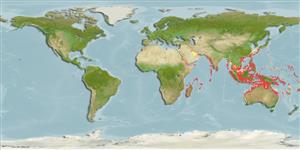Environment: milieu / climate zone / depth range / distribution range
Ökologie
seewasser riff-verbunden; tiefenbereich 2 - 65 m (Ref. 9710). Tropical; 35°N - 35°S, 26°E - 180°E (Ref. 5222)
Indo-Pacific: East Africa south to East London, South Africa and east to Fiji. Recently recorded from Tonga (Ref. 53797). It is not known from the Red Sea, but it does occur in the Persian Gulf. Record from northwestern Australia (Ref. 3132) is doubtful. It is closely related to, and is often confused with, three other white-spotted species: Epinephelus ongus, Epinephelus summana, and Epinephelus corallicola.
Length at first maturity / Size / Gewicht / Alter
Maturity: Lm ?, range 42 - ? cm
Max length : 76.0 cm TL Männchen/unbestimmt; (Ref. 6492)
Rückenflossenstacheln (insgesamt) : 11; Rückenflossenweichstrahlen (insgesamt) : 15 - 17; Afterflossenstacheln: 3; Afterflossenweichstrahlen: 8. This species is distinguished by the following characters: body depth distinctly less than head length, 2.9-3.4 in SL (for specimens 11-47 cm SL); head length 2.3-2.5 in SL; head pointed, dorsal profile almost straight; preopercle rounded, finely serrate; opercular spines inconspicuous; upper edge of operculum straight, sinuous or slightly convex; maxilla naked, mostly covered by upper lip; small or absent canines at front of jaws; midlateral part of lower jaw with 3-5 rows of small teeth; gill rakers of first gill arch 8-10 + 13-17 in juveniles and 4-8 in upper limb for adults larger than 25 cm SL; adults with ctenoid scales on body in broad zone along middle of side, cycloid elsewhere and with numerous auxiliary scales; caudal fin rounded; pectoral fins large and fleshy, with 17-19 rays, the fin length 1.5-2.1 in HL; short pelvic fins, not reaching anus, 2.0-2.7 in head length. Colour of adults brownish grey, the body covered with small pale spots overlain with large pale blotches; oblique black saddle on rear half of peduncle; 4-5 indistinct black blotches at base of dorsal fin; prominent black streak on maxillary groove; large adults brownish, covered with small, indistinct, contiguous pale spots; juveniles (less than 25 cm) dark grey to black, covered with prominent pupil-size white spots and smaller white dots (Ref. 39231, 89707, 90102).
Occurs in rocky or coral-rich areas of deep lagoons, channels and outer reef slopes; usually in or near caves (Ref. 089707). Solitary (Ref 90102). Juveniles are found in tide pools. Feeds on fish and crustaceans (Ref. 6113). In Hong Kong live fish markets (Ref. 27253). Caught with hook-and-line, spear, and in traps and probably of some importance to fisheries in areas where it is common (Ref. 39231).
Heemstra, P.C. and J.E. Randall, 1993. FAO Species Catalogue. Vol. 16. Groupers of the world (family Serranidae, subfamily Epinephelinae). An annotated and illustrated catalogue of the grouper, rockcod, hind, coral grouper and lyretail species known to date. Rome: FAO. FAO Fish. Synop. 125(16):382 p. (Ref. 5222)
IUCN Rote Liste Status (Ref. 130435: Version 2024-2)
Bedrohung für Menschen
Harmless
Nutzung durch Menschen
Fischereien: weniger kommerziell
Tools
Zusatzinformationen
Download XML
Internet Quellen
Estimates based on models
Preferred temperature (Ref.
123201): 24.6 - 29, mean 28 °C (based on 1234 cells).
Phylogenetic diversity index (Ref.
82804): PD
50 = 0.5000 [Uniqueness, from 0.5 = low to 2.0 = high].
Bayesian length-weight: a=0.01122 (0.00702 - 0.01794), b=3.00 (2.87 - 3.13), in cm total length, based on LWR estimates for this species & Genus-body shape (Ref.
93245).
Trophic level (Ref.
69278): 3.7 ±0.5 se; based on diet studies.
Widerstandsfähigkeit (Ref.
120179): niedrig, Verdopplung der Population dauert 4,5 - 14 Jahre. (Preliminary K or Fecundity.).
Fishing Vulnerability (Ref.
59153): Moderate to high vulnerability (50 of 100).
Climate Vulnerability (Ref.
125649): High to very high vulnerability (66 of 100).
Nutrients (Ref.
124155): Calcium = 21.4 [10.4, 48.2] mg/100g; Iron = 0.447 [0.241, 0.902] mg/100g; Protein = 18.5 [16.9, 19.9] %; Omega3 = 0.112 [0.069, 0.178] g/100g; Selenium = 39 [23, 70] μg/100g; VitaminA = 150 [42, 536] μg/100g; Zinc = 1.24 [0.87, 1.72] mg/100g (wet weight);
